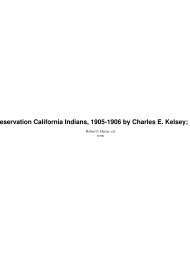YA summer '01 - Yosemite Online
YA summer '01 - Yosemite Online
YA summer '01 - Yosemite Online
You also want an ePaper? Increase the reach of your titles
YUMPU automatically turns print PDFs into web optimized ePapers that Google loves.
Face view of wolverine collected in Lyell Canyon, 1915.<br />
collecting, the current team will capture and release most<br />
of the animals. Bird populations will be assessed by<br />
observation and point counts, while mammals will be<br />
sampled through live trapping and release. A few small<br />
mammals will be taken to ensure correct identification<br />
and to provide reference material, as will some amphibians<br />
and reptiles.<br />
This year so far, UC Berkeley biologists have made<br />
four trips to the park, often packing in their food and<br />
traps on mules. The first was in May to survey <strong>Yosemite</strong><br />
Valley; followed by a trip in June to the northwest part of<br />
the park near Crane Flat and Merced Big Trees; one in<br />
early July to the Glacier Point area; and one in late July to<br />
We’re going back through the field notes containing all the original information to do an exact<br />
comparison between today and eighty years ago, which is a remarkable thing.<br />
Lyell Canyon. The team set off August 5 for a 10-day survey<br />
near the Tuolumne area at Glen Aulin. During the<br />
<strong>summer</strong> the team comprises between four and eight<br />
people, including park service biologists, who are surveying<br />
mammals, birds, reptiles, and amphibians. A separate<br />
team of herpetologists will descend on the park this fall<br />
and next spring to look for amphibians like frogs and<br />
salamanders.<br />
A museum photographer will follow up by taking<br />
photos of the same areas as did Grinnell and his crew,<br />
ideally from the exact same spot.<br />
Though the study is designed to assess the status of all<br />
vertebrates, there are some animals the park is specifically<br />
interested in because their status is currently<br />
unknown. These are not the obvious large or pervasive<br />
animals—bears, deer, owls and others —that have been<br />
the subject of previous targeted<br />
studies. Instead, the<br />
list includes a pocket<br />
mouse, two species of<br />
grasshopper mouse, six<br />
species of shrews, six<br />
species of chipmunks, and<br />
reptiles like the Western<br />
fence lizard, Western<br />
skink, sagebrush lizard,<br />
night snake, and sharptailed<br />
snake.<br />
“We’re learning there<br />
have been ecological<br />
changes within the park<br />
that until now we haven’t<br />
been able to document<br />
adequately,” said Leslie<br />
Chow, a UC Berkeley<br />
graduate now serving in<br />
<strong>Yosemite</strong> as a research<br />
wildlife biologist for the U.S. Geological Survey. “We<br />
view the park as relatively pristine because we don’t<br />
allow logging, but other actions—things like suppressing<br />
fires for a hundred years—have had an impact.”<br />
Moritz expects that other transects they survey will<br />
exhibit much greater change.<br />
“It’s our best protected landscape in California, so we<br />
are expecting <strong>Yosemite</strong> to be the benchmark against<br />
which we can compare other transects,” he said.<br />
If Thompson and Chow have their way, museum scientists<br />
will regularly visit the park to document the<br />
changes occurring in species distribution and population.<br />
“Grinnell established a baseline in the teens, and hopefully<br />
we can convince the park that this sort of monitoring<br />
needs to be done on a more regular basis,” Chow said.<br />
“We’d like to get the museum involved so it will come<br />
back every twenty years and do something like this.”<br />
“I hope this cooperation is just a springboard for further<br />
work we can do with the Museum of Vertebrate<br />
Zoology,” Thompson said. “We do need the data.”<br />
Robert Sanders is a member of the editorial staff of<br />
the Office of Public Affairs at UC Berkeley. This<br />
article originally appeared in that office's quarterly<br />
publication, the Berkeleyan, and is used with permission.<br />
All photographs are courtesy of UC<br />
Berkeley and its Museum of Vertebrate Zoology.<br />
YOSEMITE ASSOCIATION, FALL 2003<br />
5




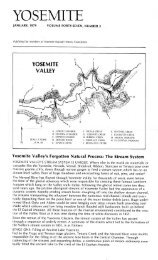
![(March 1982) [PDF] “We Are Pleased to Announce†- Yosemite Online](https://img.yumpu.com/51299748/1/190x242/march-1982-pdf-aeuroewe-are-pleased-to-announceaeur-yosemite-online.jpg?quality=85)
![[PDF] Old Horny, Yosemite's Unicorn Buck - Yosemite Online](https://img.yumpu.com/51269869/1/184x260/pdf-old-horny-yosemites-unicorn-buck-yosemite-online.jpg?quality=85)
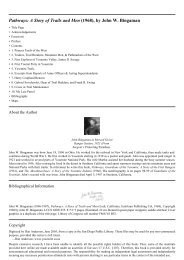
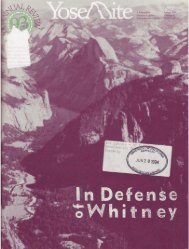
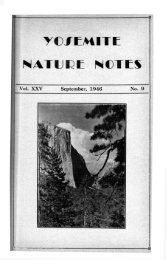
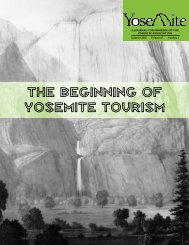
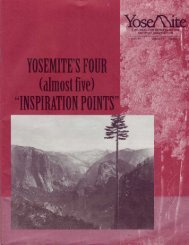
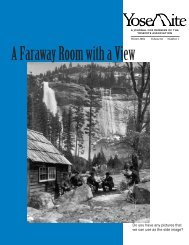
![1985 [PDF] - Yosemite](https://img.yumpu.com/48128837/1/184x260/1985-pdf-yosemite.jpg?quality=85)

